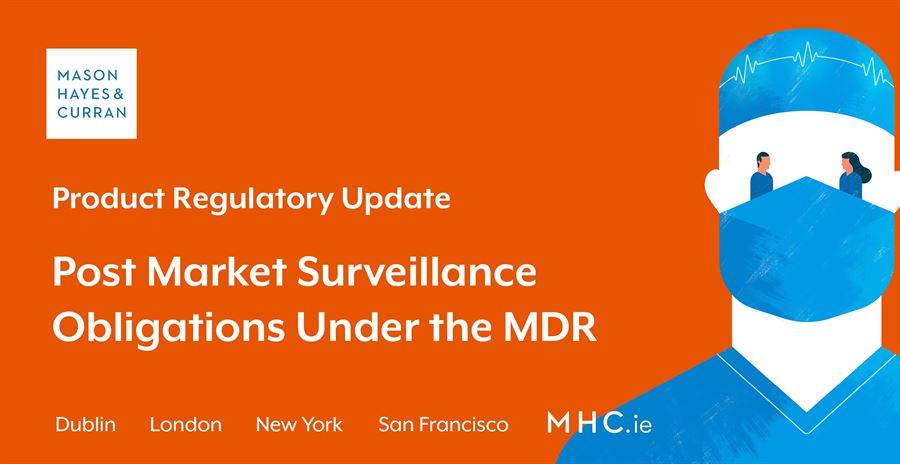
Post-Market Surveillance (PMS) obligations are an integral part of the upcoming regulatory overhaul for medical devices in Europe under the fast approaching Medical Devices Regulation (MDR). Special emphasis is now being placed on gathering clinical and safety-related data after the approval of CE certification and market access.
The MDR requires manufacturers to continually monitor the performance of medical devices once approved for market access, in order to meet its aim of greater product safety in Europe. As some risks only become apparent when medical devices are used, stored, transported or cleaned, manufacturers must now continuously ensure that their devices are safe and that there are no uncontrolled risks, such as defects or undetected security problems.
What is Post-Market Surveillance?
The MDR explicitly defines PMS for the first time, thereby removing any lack of clarity as to what is expected of manufacturers under the new legislative framework. Article 2 (60) defines ‘post-market surveillance’ as “all activities carried out by manufacturers in cooperation with other economic operators to institute and keep up to date a systematic procedure to proactively collect and review experience gained from devices they place on the market, make available on the market or put into service for the purpose of identifying any need to immediately apply any necessary corrective or preventative actions”.
The aim of PMS under the MDR is to actively and systematically gather, record and analyse relevant data on the quality, performance and safety of a device throughout its entire lifetime. This enables manufacturers to appropriately update their risk-benefit assessment and toinitiate necessary measures to their medical device products on the market. Manufacturers are also obliged to collect and assess all information about their devices and related devices from competitor products.
Manufacturers obligations under PMS
Article 83 expressly deals with PMS obligations placed upon manufacturers. For each device, manufacturers are required to document, maintain and update a PMS system which is proportionate to the risk class and appropriate for the type of device. As a result, the required PMS system should analyse the relevant data on the device’s performance and safety throughout its life cycle. This is required in order to deduct the necessary conclusions and implement the required preventative and corrective actions.
If preventative or corrective action is required, manufacturers are obliged to implement the appropriate measures as well as informing the competent authorities concerned.
The PMS Plan
Additionally, Article 84 necessitates a PMS plan to be developed for each device. The PMS plan is also to be prescribed within the technical documentation for devices. Annex III of the Regulation details what is required within a PMS plan. It shall address the collection and utilization of information, in particular:
-
Information concerning serious incidents, including information from periodic safety update reports (PSURs) and field safety corrective actions
-
Records referring to non-serious incidents and data on any undesirable side-effects
-
Information from trend reporting
-
Relevant specialist or technical literature, databases and/or registers
-
Information, including feedbacks and complaints, provided by users, distributors and importers, and
-
Publicly available information about similar medical devices
The appropriate plan should enable a comparison to be made between the device and similar products that are on the market.
MDCG Guidance
The Medical Device Coordination Group (MDCG) has issued guidance on PMS and in particular post-market clinical follow-up (PMCF), which is to form part of manufacturers’ PMS plans. The guidance states, “A PMCF plan shall specify the methods and procedures set up by the manufacturer, to proactively collect and evaluate clinical data from the use in or on humans of a CE marked medical device, placed on the market or put into service within its intended purpose, as referred to in the relevant conformity assessment procedure”.
PMCF findings are intended to be scrutinised by manufacturers whom should then document the results in a PMCF evaluation report. This report is to be included with the devices clinical evaluation report and technical documentation. Guidance on what is to be included in a PMCF evaluation report, and how it should be presented has also been published which can be found here. The adequateness of the PMCF plan and its application is subject to assessment by the Notified Body involved.
PMS Report
Article 85 obliges manufacturers of class I devices to prepare a PMS report summarising and detailing the results and conclusions derived from analysing the data gathered from the PMS plan. The report must also contain a summary of the manufacturer’s rationale and descriptions of any preventative or corrective actions taken. It must be updated as and when necessary and must be made available to the competent authority upon request.
For class IIa, class IIb and class III devices, Article 86 prescribes that manufacturers must prepare a periodic safety update report (PSUR) for each device and where relevant for each category or group of devices. The PSUR must summarise the results and conclusions of the data gathered from their PMS plan, together with inputting the manufacturer's rationale and descriptions of any preventative or corrective actions taken.
Manufacturers of class IIb and III must update their PSUR annually, while manufactures of class IIa are required to do so at least every two years. In the case of class III or implantable devices, the PSUR must be submitted annually to the Notified Body involved.
Conclusion
PMS represents one of the core focus areas of the new MDR. Plans must be maintained, documented and updated throughout the product's lifecycle. Many manufactures will be required to implement more stringent PMS procedures and to conduct more PMCF studies in order to meet the expectations of their Notified Bodies.
Understanding the increased obligations now placed on manufacturers associated with PMS requirements is essential for manufacturers to comply with the MDR. Preparations should commence as soon as possible in order to ensure smooth transition from MDD obligations to those of the MDR and legal advice should be obtained where manufactures are unclear of what is expected of them.
For more information and expert advice on complying with the MDR, contact a member of our Product Regulatory team.
The content of this article is provided for information purposes only and does not constitute legal or other advice.
Share this:






